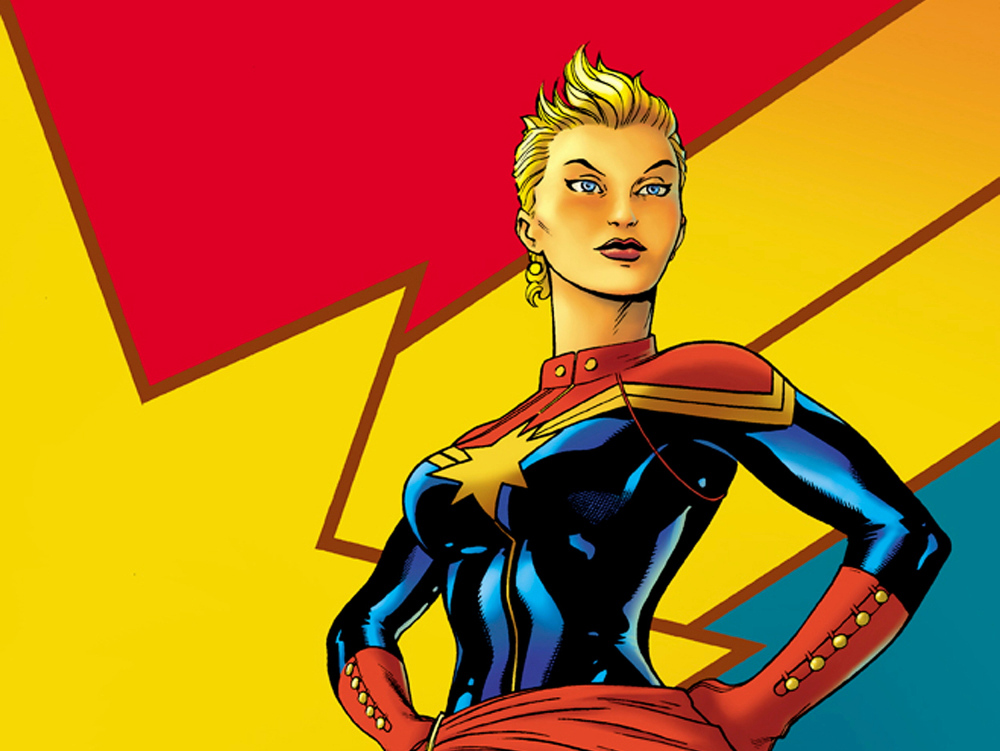Unsung Heroes: Captain Marvel rises as feminist superhero through modern updates

Carol Danvers first debuted as Ms. Marvel in the 1960s, before being updated as Captain Marvel in 2012. As a member of the Avengers, Danvers has emerged as a feminist superhero.
(Marvel Comics)
By Aubrey Yeo
March 30, 2015 12:00 a.m.
Marvel Comics has seen an increase in mainstream popularity with the recent release of several box office hits, such as “The Avengers.” Since its inception in 1939, the comic book company has created thousands of characters. While not all of them may get their due publicity because of a lack of exposure in the silver screen, each has interesting stories to tell in the print medium.
It started with the musings of a mad Scarlet Witch.
The House of M universe that transpired in the wake of Scarlet Witch’s reality warping powers created a universe where mutants reigned supreme, while humans took a back seat.
Although she wasn’t a mutant, Carol Danvers, then known as Ms. Marvel, maintained a status as the most popular super hero in America according to “House of M,” Issue 1. It would also be the first time she used the moniker “Captain Marvel.”
Once the Marvel universe returned to its status quo, so did Danvers’ rapport with the public. While battling Stilt-Man in the first issue of the new eponymous, “Ms. Marvel” series, her lesser-known foe would ironically deal the biggest blow through his words.
“Who the hell are you supposed to be anyway?” Stilt-Man said in Volume 2, Issue 1 of “Ms. Marvel.”
The insecurity sparked a rant with best friend Jessica Drew, aka Spider-Woman, explaining the ordeal at hand, or rather voice of the villain. That was in 2006.
Fast forward to today and Danvers has paved her way as a mainstay in Marvel’s premier terrestrial superhero team, the Avengers, while also being a prominent member of the company’s cosmic counterpart, the Guardians of the Galaxy. But this rise of prominence in the comic book universe doesn’t come without some change.
Danvers has since dropped the gender-specific prefix “Ms.” for a more gender-inclusive alternative in “Captain,” taking over the mantle from her mentor from whom she received her powers from. Captain Marvel has also dropped the iconic black “Baywatch”-styled one-piece suit with a lightning bolt and thigh-highs, instead replacing it with a less-revealing body suit that comes fully-equipped with a convertible flight helmet – apparel that seems to suit her fighter pilot persona better.
It seems to me that Danvers’ quest to be a better superhero was a microcosm for Marvel’s own direction for the company. Prior to her tasting the peak of her potential in “House of M,” Danvers was subjected to some poor storylines, being a prime example of what feminist comic book writer Gail Simone termed “Women in Refrigerators.“
Danvers was mind-controlled by Marcus Immortus and used as a vessel to bring his mortal form into the world through a pseudo-pregnancy, becoming both his mother and wife. Although she would eventually regain her lucidity, she would lose her powers and was placed in a comatose state by the X-man Rogue, who at the time was a supervillian operating under the guidance of Mystique. Danvers would regain her consciousness and memory with the help of Professor X, but remained stripped of her powers, relegating her from Avenger to an auxiliary member of the X-Men. The modern-day Carol Danvers has broken free of the trend of being shoved aside.
Danver’s first run as Captain Marvel in 2012 explores the feminist side of the hero that once served as an editor at the fictional WOMAN magazine. The inaugural story arc of the new Captain Marvel series explores the hero’s relationship with her idol, Helen Cobb, a pioneer pilot who broke several speed records during her heyday. In fact, it was Cobb’s passing that inspired Danvers to don the name Captain Marvel, after previously declining Captain America’s initial suggestion. It’s also during this storyline where her experience as a fighter pilot with both the U.S. Air Force and NASA are juxtaposed with her meeting the Banshees from the past – members of a World War II civil service ferry pilots who were treated differently.
The Captain Marvel character in its present-day form has landed itself in a position as a better beacon of gender equality for Marvel despite being less known than other feminist alternatives, such as the rebranding of a Big Three member, Thor, as female, or spotlighting Black Widow kicking butt in the cinematic universe. This is mainly because the character holds similar ideals of women empowerment and translates them to the reader through her actions, personality and especially achievements in two domains that were once extremely male-dominated – aeronautics and the military.
Ultimately her comfort in being a woman with power is shown in Issue 1 of “Captain Marvel,” particularly with how Danvers handles a misogynist remark delivered by the Absorbing Man that admonishes Captain America for taking orders from a woman.
“This broad left the service a full bird colonel. So technically, I outrank him,” she said.
Not many people get to boss around the leader of the Avengers.
Who’s your favorite Marvel superhero not seen on the silver screen? Email Yeo at [email protected].


